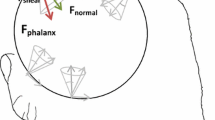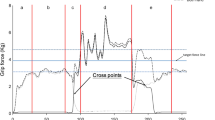Abstract
Despite numerous studies that show force regulation is impaired after stroke, two recent studies suggest that the ability to regulate submaximal, isometric grip forces may remain substantially intact. Here we asked how this aspect of hand motor control, measured for both a power grip and pinch grip, compares to two other key aspects of hand function–grip strength and dexterity. For 20 individuals with a range of hand impairment levels in the chronic phase of stroke (Age: 62 ± 16.0 years, Time post stroke: 958.3 ± 966.5 days, Sex: 19 M 1F) we quantified the average rate of target acquisition for force targets in the range of 3 to 30% maximum voluntary contraction as participants used the two different grips to squeeze a force sensor to control a cursor on a screen. The same force sensor was used to assess subject grip strength for the two grips, while dexterity was assessed using the Box and Blocks Test (BBT), and the Nine Hole Peg Test (NHPT) for both the paretic and non-paretic hand. On average, the relative rate of force acquisition of the paretic hand using a power grip was 74.0 ± 18.6 SD % of the non-paretic hand, a value significantly higher than the 48.6 ± 25.6 SD% for grip strength (paired t test, p < .005) or the 41.4 ± 29.1 SD % (p < .005) and 23.3 ± 30.1 SD % (p < .005) for the BBT and NHPT, respectively. Results were similar for the lateral pinch grip, suggesting similar thumb force tracking performance. Grip force tracking, measured as rate of force acquisition, is less impaired after stroke than hand strength or dexterity, a finding with implications for the neural mechanisms of stroke and the design of assistive technologies.




Similar content being viewed by others
Availability of data and materials
The data sets generated for this study are available on request to the corresponding author. Requests to access the data sets should be directed to qsanders@gmu.edu (Quentin Sanders).
Code availability
Not applicable.
References
Boissy P, Bourbonnais D, Carlotti MM et al (1999) Maximal grip force in chronic stroke subjects and its relationship to global upper extremity function. Clin Rehabil. https://doi.org/10.1191/026921599676433080
Bos RA, Haarman CJW, Stortelder T et al (2016) A structured overview of trends and technologies used in dynamic hand orthoses. J Neuroeng Rehabil 13:1–25
Brouwer BJ, Schryburt-Brown K (2006) Hand function and motor cortical output poststroke: are they related? Arch Phys Med Rehabil. https://doi.org/10.1016/j.apmr.2006.02.006
Cauraugh JH, Kim SB (2003) Chronic stroke motor recovery: duration of active neuromuscular stimulation. J Neurol Sci. https://doi.org/10.1016/S0022-510X(03)00169-2
Grice KO, Vogel KA, Le V et al (2003) Adult norms for a commercially available nine hole peg test for finger dexterity. Am J Occup Ther 57:570–573. https://doi.org/10.5014/ajot.57.5.570
Jones CL, Kamper DG (2018) Involuntary neuromuscular coupling between the thumb and finger of stroke survivors during dynamic movement. Front Neurol. https://doi.org/10.3389/fneur.2018.00084
Kamper DG (2016) Restoration of hand function in stroke and spinal cord injury. In: Reinkensmeyer DJ, Dietz V (eds) Neurorehabilitation Technology, 2nd edn. Springer International Publishing, Cham
Kamper DG, Fischer HC, Cruz EG, Rymer WZ (2006) Weakness is the primary contributor to finger impairment in chronic stroke. Arch Phys Med Rehabil. https://doi.org/10.1016/j.apmr.2006.05.013
Kamper DG, Fischer HC, Conrad MO et al (2014) Finger-thumb coupling contributes to exaggerated thumb flexion in stroke survivors. J Neurophysiol 111:2665–2674. https://doi.org/10.1152/jn.00413.2013
Kang N, Cauraugh JH (2015a) Paretic hand unimanual force control: Improved submaximal force production and regularity. Neurosci Res. https://doi.org/10.1016/j.neures.2014.12.005
Kang N, Cauraugh JH (2015b) Force control in chronic stroke. Neurosci Biobehav Rev 52:38–48
Lang CE (2004) Human finger independence: limitations due to passive mechanical coupling versus active neuromuscular control. J Neurophysiol 92:2802–2810. https://doi.org/10.1152/jn.00480.2004
Lang CE, DeJong SL, Beebe JA (2009) Recovery of thumb and finger extension and its relation to grasp performance after stroke. J Neurophysiol. https://doi.org/10.1152/jn.91310.2008
Lindberg P, Schmitz C, Forssberg H et al (2004) Effects of passive-active movement training on upper limb motor function and cortical activation in chronic patients with stroke: a pilot study. J Rehabil Med. https://doi.org/10.1080/16501970410023434
Lindberg PG, Roche N, Robertson J et al (2012) Affected and unaffected quantitative aspects of grip force control in hemiparetic patients after stroke. Brain Res. https://doi.org/10.1016/j.brainres.2012.03.007
Lodha N, Naik SK, Coombes SA, Cauraugh JH (2010) Force control and degree of motor impairments in chronic stroke. Clin Neurophysiol. https://doi.org/10.1016/j.clinph.2010.04.005
Lodha N, Misra G, Coombes SA et al (2013) Increased force variability in chronic stroke: Contributions of force modulation below 1 Hz. PLoS ONE. https://doi.org/10.1371/journal.pone.0083468
Mathiowetz V, Volland G, Kashman N, Weber K (1985) Adult norms for the box and block test of manual dexterity. Am J Occup Ther off Publ Am Occup Ther Assoc 39:386–391. https://doi.org/10.5014/ajot.39.6.386
Moritz CT, Barry BK, Pascoe MA, Enoka RM (2005) Discharge rate variability influences the variation in force fluctuations across the working range of a hand muscle. J Neurophysiol. https://doi.org/10.1152/jn.01122.2004
Naik SK, Patten C, Lodha N et al (2011) Force control deficits in chronic stroke: grip formation and release phases. Exp Brain Res. https://doi.org/10.1007/s00221-011-2637-8
Nudo RJ (2007) Postinfarct cortical plasticity and behavioral recovery. Stroke 38:840–845. https://doi.org/10.1161/01.STR.0000247943.12887.d2
Nudo RJ (2013) Recovery after brain injury: mechanisms and principles. Front Hum Neurosci. https://doi.org/10.3389/fnhum.2013.00887
Parikh P, Davare M, McGurrin P, Santello M (2014) Corticospinal excitability underlying digit force planning for grasping in humans. J Neurophysiol. https://doi.org/10.1152/jn.00815.2013
Patel P, Kaingade SR, Wilcox A, Lodha N (2020) Force control predicts fine motor dexterity in high-functioning stroke survivors. Neurosci Lett. https://doi.org/10.1016/j.neulet.2020.135015
Rinne P, Mace M, Nakornchai T et al (2016) Democratizing neurorehabilitation: how accessible are low-cost mobile-gaming technologies for self-rehabilitation of arm disability in stroke? PLoS ONE 11:1–12. https://doi.org/10.1371/journal.pone.0163413
Sanders Q, Okita S, Lobo-Prat J, et al (2018) Design and control of a novel grip amplifier to support pinch grip with a minimal soft hand exoskeleton. In: Proceedings of the IEEE RAS and EMBS International Conference on Biomedical Robotics and Biomechatronics
Smith BW (2017) Unexpected elements of human force control and instances of preservation after severe stroke: implications for optimality. Variability and Rehabilitation Technology. University of California, Irvine
Smith BW, Rowe JB, Reinkensmeyer DJ (2018a) Real-time slacking as a default mode of grip force control: implications for force minimization and personal grip force variation. J Neurophysiol. https://doi.org/10.1152/jn.00700.2017
Smith BW, Rowe JB, Reinkensmeyer DJ (2018b) Directly measuring the rate of slacking as stroke survivors produced isometric forces during a tracking task. In: Proceedings of the Annual International Conference of the IEEE Engineering in Medicine and Biology Society, EMBS
Thickbroom GW, Byrnes ML, Archer SA, Mastaglia FL (2002) Motor outcome after subcortical stroke: MEPs correlate with hand strength but not dexterity. Clin Neurophysiol. https://doi.org/10.1016/S1388-2457(02)00318-8
Towles JD, Kamper DG, Rymer WZ (2010) Lack of hypertonia in thumb muscles after stroke. J Neurophysiol 104:2139–2146. https://doi.org/10.1152/jn.00423.2009
Triandafilou KM, Fischer HC, Towles JD et al (2011) Diminished capacity to modulate motor activation patterns according to task contributes to thumb deficits following stroke. J Neurophysiol 106:1644–1651. https://doi.org/10.1152/jn.00936.2010
Ward NS, Newton JM, Swayne OBC et al (2007) The relationship between brain activity and peak grip force is modulated by corticospinal system integrity after subcortical stroke. Eur J Neurosci. https://doi.org/10.1111/j.1460-9568.2007.05434.x
Funding
National Institutes of Health, R44HD086953, David Reinkensmeyer, R01HD062744, David Reinkensmeyer
Author information
Authors and Affiliations
Corresponding author
Ethics declarations
Conflict of interest
The authors declare that they have no conflict of interest.
Ethics approval
This study was approved by the Institutional Review Board of the University of California, Irvine.
Consent to participate
All participants gave their informed consent before participation in the study.
Consent for publication
All authors read and approved the final version of this manuscript and consented to submit the manuscript for publication.
Additional information
Communicated by Bill J Yates.
Publisher's Note
Springer Nature remains neutral with regard to jurisdictional claims in published maps and institutional affiliations.
Rights and permissions
About this article
Cite this article
Sanders, Q., Chan, V., Stoller, O. et al. Force acquisition frequency is less impaired compared to grip strength or hand dexterity in individuals with chronic stroke. Exp Brain Res 240, 2513–2521 (2022). https://doi.org/10.1007/s00221-022-06432-5
Received:
Accepted:
Published:
Issue Date:
DOI: https://doi.org/10.1007/s00221-022-06432-5




